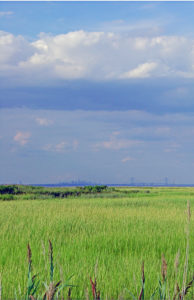“It is a place that can make nature-worshipers out of non-believers”
In this photo essay,Fish and Ships I hope to share my knowledge and love of the Estuary’s beautiful waterscape through photographs. of the working waterfront, wildlife, and wetlands that border the Harbor, The photographs taken from the Baykeeper Boat over an almost twenty year period describe the ecological and human uses of this confluence of the New York and New Jersey’s largest rivers and the Bays of New York Harbor and the Atlantic Ocean.
The Hudson-Raritan Estuary marks the watery end of New York and New Jersey’s largest rivers – the Hudson, Hackensack, Passaic, Rahway, Shrewsbury, Navesink, and Raritan Rivers. The Harbor Estuary is one of the most studied and well documented in the World but few know it well. I had the honor and privilege of serving as the Baykeeper for the Bays and tributaries to the Hudson-Raritan (NY/NJ Harbor) Estuary from 1989 to 2008. Part of my job was to document what I saw as I patrolled the bays and rivers of the Harbor. 
My other job was to tell the story of the Harbor as an ecological system, to record insults to it, and to develop strategies for its restoration. I hope that this narrative and photographs will begin to tell that story of the working waterfront, the wetlands, waterways, and the people who work on and live nearby, that collectively are the threads of the tapestry that is the Harbor and the urban coast.
This urban wilderness is astonishing, not just for its beauty and bounty but for its diversity and tenacity. It is a place that can make nature worshipers out of non- believers. This extraordinary collection of rivers, harbors, bays, beaches, uplands, and primal mud is a celebration of water people, fish, commerce, and nature. It is the reason people settled here, and it is still the glue that holds the bio-region together.
It is a living web of upland, fresh and salt water marshes, beaches, straits, and broad bays. It is home to more than 150 species of fish, 300 bird species, and 20 million people. It feeds vast schools of migrating herring, shad, and striped bass, flocks of songbirds and raptors. It nourishes people who eat from its bounty and seek recreation and rejuvenation in nature. It is also the world’s most urban harbor – a metropolitan mosaic of shimmering glass towers, looping highways, and gritty refineries, it is a region teeming with life and in need of ecological repair.
 The Estuary — where freshwater streams mix with salty tides — cuts deeply into the coast, a 20-mile indent with 800 miles of shoreline. At the upper cusp is the western tip of Long Island. The Estuary swings counterclockwise from there and sweeps past New York City to New Jersey’s urban coast. At the southern end is the needle-thin peninsula of Sandy Hook
The Estuary — where freshwater streams mix with salty tides — cuts deeply into the coast, a 20-mile indent with 800 miles of shoreline. At the upper cusp is the western tip of Long Island. The Estuary swings counterclockwise from there and sweeps past New York City to New Jersey’s urban coast. At the southern end is the needle-thin peninsula of Sandy Hook
 We live in a time of transition – movement into the Ecozoic Era, as Thomas Berry has called it. Signs are increasingly apparent: Peak oil, climate unpredictability, and ecological and economic instability. How are we to live into such a moment with intention and hope? How can we act on our commitment to life and the common good?
We live in a time of transition – movement into the Ecozoic Era, as Thomas Berry has called it. Signs are increasingly apparent: Peak oil, climate unpredictability, and ecological and economic instability. How are we to live into such a moment with intention and hope? How can we act on our commitment to life and the common good?
Local Groups like Baykeeper are one way of getting to our future by design or default. “We can have a future we like, rather than the one we’re likely to get”.



